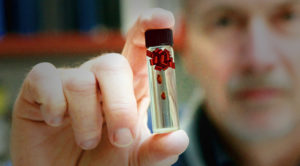by Gabe Saldana and Paul Schattenberg, Texas A&M Agrilife Communications
DALLAS — Texas A&M AgriLife Extension Service entomologists say a few simple practices can help holiday travelers deal with bedbug infestations and avoid spreading the pest.

Texas A&M AgriLife Extension Service urban entomologist Dr. Mike Merchant shows a vial of adult bed bugs. (Texas A&M AgriLife Illustration by Gabe Saldana)
“All it takes is one traveler with bedbugs in their luggage to stay at a hotel and that hotel can become infested,” said Dr. Mike Merchant, AgriLife Extension urban entomologist in Dallas. “Unless the problem is noticed and dealt with right away, the next hotel visitor may end up bitten or bringing home some unwanted hitchhikers.”
Bedbugs are reddish brown, flat and about the size of apple seeds in their adult stages. Younger specimens can be as small as pinheads, Merchant said. They typically prefer living within 5 feet of where humans sleep, but can spread between rooms as populations begin to crowd.

Adult bedbug on skin (Texas A&M AgriLife Extension Service photo)
He recommended travelers make it a habit to set suitcases and personal items on clean luggage racks, and away from beds and upholstered furniture.
“The most common hiding places for bedbugs in hotels are around bed headboards and upholstered furniture,” Merchant said. “Linens get changed regularly, disturbing bedbugs, so they don’t like to live directly on beds, but the headboard and frame never get moved, so they will persist there.”
Placing luggage in the bathtub is another option since it has smooth sides that are difficult for bedbugs to scale, said Wizzie Brown, AgriLife Extension entomologist, Travis County.
“Before bringing your luggage into the hotel or motel room, pull back the bedding to expose the mattress and box springs and check them, especially the areas near the seams and tags and the bottom of the box spring,” Brown said. “In addition to the headboard, it’s also a good idea to inspect items near the bed, such as lamp bases and nightstands.”
Brown said bedbugs also can be found under cushions, behind picture frames, behind baseboards and in back of electrical switch plates.
Merchant recommended reporting suspected bedbugs to hotel management immediately upon detection.
“If you think you may have stayed in a bedbug infested room, put your clothing directly into the laundry when you get home,” he said. “Don’t bring your luggage into the living or sleeping areas of your home.
“Thirty minutes of a high temperature wash followed by at least 30 minutes of high temperature drying should take care of any bedbugs that might have come home in your suitcase.”
Brown said if changing rooms isn’t an option, have housekeeping vacuum thoroughly to remove as many bedbugs and their eggs from mattresses, box springs, carpets and other areas as possible.
“I’d personally never want to stay in a room knowing there were bedbugs present, but if you’re stuck and there’s no other room available at that or at any other lodging, have housekeeping vacuum thoroughly, concentrating on mattress and box springs seams, tufts and edges, plus areas where the baseboards and carpet meet.”
For comprehensive information on bedbug identification and control measures, go to the bedbug page at Merchant’s Insects in the City blog, https://citybugs.tamu.edu/factsheets/biting-stinging/bed-bugs/.